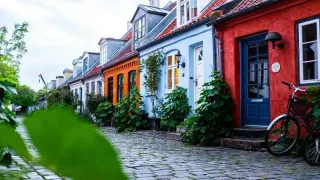October 4, 2018
Into the Wild: Sabi Sabi Private Game Reserve
Matthew Wexler READ TIME: 7 MIN.
It is one of the most iconic safari destinations in the world. But when it comes to Sabi Sabi Private Game Reserve, how is just as important as where. The attention to detail, highly trained staff and exquisite range of accommodations has earned Sabi Sabi copious accolades, and with good reason.
Going on an African safari – especially for U.S. travelers with limited vacation time and facing a day's worth of flight time – is no small decision. Travel enthusiasts will bank vacation days, pack their lunches instead of eating out, forgo those post-holiday sales all with the intention of fulfilling the dream of seeing the Big Five (lion, leopard, rhino, buffalo and elephant) and experiencing one of the picturesque landscapes on the planet. Is it worth it? If you're headed to Sabi Sabi, the answer is a resounding yes.
Sabi Sabi's name is derived from "tsave," which translates from the Tsonga dialect and means fear or danger, referencing the crocodile and hippo that populated the Sabi River when it was first traversed in 1830. Gold was discovered in the region and a railway link was built to connect the newly discovered commodity to coastal communities.
Sabi Sabi as its known today was established in 1979 and has slowly accumulated land within Kruger National Park, known throughout the world as one of the country's most diverse and populated game reserves. Over the years, four separate lodges have been built, each with unique character and design elements. Whether you are traveling on a romantic honeymoon or with friends or family, each property boasts bespoke features to entice and indulge each and every guest.
Experiencing the Bush
While at Sabai Sabi, plan on rising before the sun and enjoying evenings that linger well into the night. Lodges are within Sabi Sand Game Reserve, which is integrated into Kruger. This proximity enables jaw-dropping access to an array of wildlife above and beyond the Big Five. Peer into the trees and gaze toward the horizon to see 300 species of birds, or opt for a guided bush walk to talk a closer look at the various indigenous plants and perhaps catch a glimpse of one or more of the 11 species of owls.
But the real wow factor is hopping into the back of an open-air jeep and heading deep into the bush. The camaraderie between ranger and tracker is evident as participants traverse the landscape. It's this synergy that makes Sabi Sabi's safari's exceptionally exciting. Recent rare sitings have including mating leopards, the whimsically featured Southern Ground Hornbill, and the cute-from-a-distance Lesser Bushbaby (these tiny primates urinate on their hands and then rub their feet to mark territory).
Rangers provide on-the-spot photography tips, but for those who want an even more immersive experience, Sabi Sabi also offers photographic safaris helmed by professional photographers with the opportunity to rent equipment. They even provide tips on editing and guests receive a CD or flash drive with their personal image bank. (Photographic safaris is subject to availability and must be booked in advance.)
A Taste of South Africa
Each one of Sabi Sabi's lodges offers its own riff on South African cuisine, but there are several "must-haves" during any safari experience. Bomas originated as enclosures to contain wildlife and have evolved into gathering places to convene after a day in the bush. It is here that braais are held -- communal barbecues featuring game meats, local dishes, and a curated wine list.
Bountiful pastries are available for the taking in the dark hours before the sun rises, though most gravitate toward black coffee to jumpstart the day. Afternoon tea seems like a much more civilized time to slather clotted cream and jam onto freshly baked scones. Sunset safaris typically include time to step out of the vehicle and take in the surroundings. And there's no better place to have a sip of Amarula. Made from Marula fruit, this Bailey's-esque liqueur is aged in French oak then blended with cream for a unique spirit.
For an incomparable culinary climax, consider a meal in the Earth Lodge's wine cellar. It is here that head chef Conradie Kruger and his team combine classic technique with South African traditions to create tasting menus that leave an impression. Guests also have the opportunity for a firsthand look at Sabi Sabi's award-winning wine list.
"It's very important to know what our guests are drinking and balance with what we'd like to see them drinking!" says Sabi Sabi's marketing director Jacques Smit, who acknowledges the challenges of catering to a discerning clientele. "If they have distinct choices based on international wines, we'll try to find an equivalent from local producers. It's not our aim to convert, but rather introduce." This includes a collaboration with Stellenrust Estate and an experimental "bush maturation" process, resulting in on-site, hand bottled wines that can only be had at Sabi Sabi's Earth Lodge.
Sleeping in Paradise
Sabi Sabi offers four distinct lodge options:
Earth Lodge -- The undulating and organic flow is a standout among Sabi Sabi's offerings and embraces the region's mineral resources with metallic touches throughout. Private patios and plunge pools create an intimate environment to convene with the surroundings, while a sunken fire pit and jaw-dropping wood carvings by artist Geoffrey Armstrong add even more wow factor.
Selati Camp -- The seven-suite lodge pays homage to the region's long rail history with each of the suites named after long-gone railway stations. Antique furnishings appear throughout, along with the warm glow of lanterns as the sun sets. Located on the Msuthlu River, Selati is perhaps the most romantic and secluded of the four lodges, offering a breathtaking and private respite.
Bush Lodge -- Self-described as "a luxury home in the bush," Bush Lodge is family-friendly and displays eclectic design elements drawn from throughout the African continent. The lodge is comprised of 25 luxury suites and features two swimming pools, covered decks to take in the scenery, and the Amani Spa , which offers classic massage options as well as locally inspired ritual offerings, such as the Jewel of Africa massage, which uses salt crystals and coconut balm for a restorative and energizing treatment.
Little Bush Camp -- The ideal takeover for a family reunion or family gathering, Little Bush Camp's six private suites and common areas recently received a glorious redesign. Highlights include floor-to-ceiling handpainted chevrons, quartz floors, cozy seating areas in natural fabrics and leather, and hanging chairs to curl up with a glass of South African wine.
LGBTQ Intel
Durban Gay & Lesbian Film Festival -- More than 50 film are being shown at this epic LGBTQ event, including a director's cut of "George Michael: Freedom"; "Kings, Queens & In-Betweens" about eight performers navigating the drag club scene in Columbus, Ohio; and the British feature "Faces" by award-winning British-Nigerian filmmaker Joseph Adesunloye. (September 21-30, 2018)
Cape Town Pride Festival -- 2019 will mark the festival's 15th anniversary, February 22 - March 3, 2019.
Durban Pride -- Held each June, Durban Pride draws thousands of participants which includes a Liberation March and Festival.






